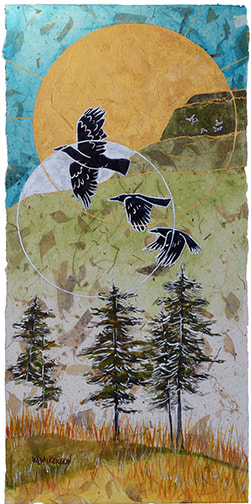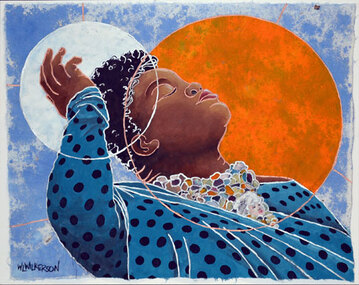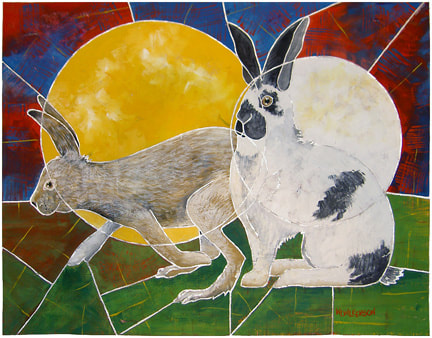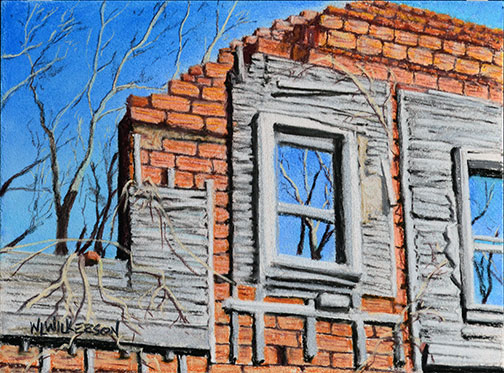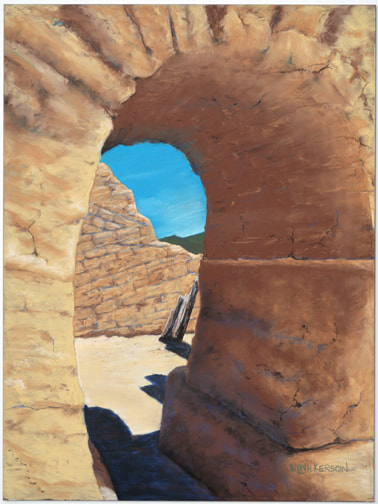Interview With Artist
Wendy Wilkerson
Wendy Wilkerson
Incoming Triptych
TNYO: Hello Wendy it was such a great pleasure to find your artwork.
I have so many questions about your art as well as your husband Bob.
Firstly, can you tell us about the YUNNAN School of art and why this approach is one of your directions and processes in art?
Wendy Wilkerson: In 1998, my husband was traveling in China and bought a painting done in the Yunnan School style. (The following explanation is an excerpt from the website China Art Files): "The style of the Yunnan School emphasizes the linear quality of objects by outlining them with thin black, gold, or silver lines. The flattened shapes are filled in with vibrant colors, using an ancient Chinese technique called zhongcai (“heavy colors”). In the late 1970s, painters in Yunnan Province combined the heavy color method with motifs from ancient Buddhist cave paintings, and the flat, distorted figures found in Western cubism and fauvism, typically associated with Picasso, Miro and Matisse. What was more, the paintings integrated imagery that had been shunned during the Cultural Revolution, such as Buddhist symbols, elements from Chinese mythology, as well as body paintings and tattoos used by some ethnic minorities. The patterns found on tribal clothing also influenced the colors and imagery frequently seen in the Yunnan School paintings."
When he showed the painting to me, I became fascinated by the work on rice paper with gouache. I had worked with gouache for many years as a commercial artist. The vibrancy of the colors and the way it worked on the rice paper captured my creative exploration. Over the years, I have developed my own images influence by the work of the Yunnan School artists.
TNYO: I find it incredibly interesting that you co-exist with your husband, a sculptor and you, a painter. Strangely enough I am in a deep relationship with a realist painter and I am an impressionist and abstractionist. Can you tell us a little bit about how this relationship developed and also how having a family under these magical circumstances work or maybe sometimes have some minor difficulties?
Wendy Wilkerson: I have always worked in the arts. My husband, a corporate consultant, took up wood carving after I encouraged him to find a creative outlet to de-stress from his work. He had worked in textiles many years prior, but his career left him very little time for his art. His first carving was of a mask, made exclusively with a pocket knife. Now, he has an entire studio filled with saws, drills, chisels, and all sorts of equipment to facilitate his unique wood sculptures. We do discuss our individual pieces; I’ll ask his opinion on an image I’m painting, and he’ll ask me what I think about the direction he’s taking one of his sculptures. I must admit that there are some pieces of his that I don’t like, and there are some of mine that he’s not terribly fond of. However, the only time things may get out of sorts is when I find wood chips in our bed, or if I become so absorbed in a painting that I forget to cook dinner.
TNYO: How does nature affect you and why do you use these natural references in your work?
Wendy Wilkerson: The natural world is fascinating. Nothing is the same, even from moment to moment.
Watching the sun rise and/or set and the colors that explode across the landscape cannot be appreciated other than to experience it directly in Nature. The way a raven flies across the sky, or two crows sitting in a tree that seem to be having a conversation; these things are what take us out of our self-absorbed life and make us more alive. So, using these images are what gives my paintings the unique characteristics and emotions found in my work.
TNYO: Where are you originally from, I read in your bio that you have been painting since childhood. Do you see your art being a result of instinct and a need to create as this is what you were born to do?
Wendy Wilkerson: I was born in Ohio and raised along the North Coast with two older sisters. I was always very imaginative, choosing to play outside, and spent a great deal of time with my Grandmothers. One was very talented in ceramics, and whom I credit my initial interest in art. She encouraged me to draw, along with my middle sister, who is also a highly recognized artist. It was by tracing my sister's drawings that I learned about form and line. Interestingly, my eldest sister has recently taken up oil painting, and has also become quite prolific. Evidently, art runs in our blood.
I have so many questions about your art as well as your husband Bob.
Firstly, can you tell us about the YUNNAN School of art and why this approach is one of your directions and processes in art?
Wendy Wilkerson: In 1998, my husband was traveling in China and bought a painting done in the Yunnan School style. (The following explanation is an excerpt from the website China Art Files): "The style of the Yunnan School emphasizes the linear quality of objects by outlining them with thin black, gold, or silver lines. The flattened shapes are filled in with vibrant colors, using an ancient Chinese technique called zhongcai (“heavy colors”). In the late 1970s, painters in Yunnan Province combined the heavy color method with motifs from ancient Buddhist cave paintings, and the flat, distorted figures found in Western cubism and fauvism, typically associated with Picasso, Miro and Matisse. What was more, the paintings integrated imagery that had been shunned during the Cultural Revolution, such as Buddhist symbols, elements from Chinese mythology, as well as body paintings and tattoos used by some ethnic minorities. The patterns found on tribal clothing also influenced the colors and imagery frequently seen in the Yunnan School paintings."
When he showed the painting to me, I became fascinated by the work on rice paper with gouache. I had worked with gouache for many years as a commercial artist. The vibrancy of the colors and the way it worked on the rice paper captured my creative exploration. Over the years, I have developed my own images influence by the work of the Yunnan School artists.
TNYO: I find it incredibly interesting that you co-exist with your husband, a sculptor and you, a painter. Strangely enough I am in a deep relationship with a realist painter and I am an impressionist and abstractionist. Can you tell us a little bit about how this relationship developed and also how having a family under these magical circumstances work or maybe sometimes have some minor difficulties?
Wendy Wilkerson: I have always worked in the arts. My husband, a corporate consultant, took up wood carving after I encouraged him to find a creative outlet to de-stress from his work. He had worked in textiles many years prior, but his career left him very little time for his art. His first carving was of a mask, made exclusively with a pocket knife. Now, he has an entire studio filled with saws, drills, chisels, and all sorts of equipment to facilitate his unique wood sculptures. We do discuss our individual pieces; I’ll ask his opinion on an image I’m painting, and he’ll ask me what I think about the direction he’s taking one of his sculptures. I must admit that there are some pieces of his that I don’t like, and there are some of mine that he’s not terribly fond of. However, the only time things may get out of sorts is when I find wood chips in our bed, or if I become so absorbed in a painting that I forget to cook dinner.
TNYO: How does nature affect you and why do you use these natural references in your work?
Wendy Wilkerson: The natural world is fascinating. Nothing is the same, even from moment to moment.
Watching the sun rise and/or set and the colors that explode across the landscape cannot be appreciated other than to experience it directly in Nature. The way a raven flies across the sky, or two crows sitting in a tree that seem to be having a conversation; these things are what take us out of our self-absorbed life and make us more alive. So, using these images are what gives my paintings the unique characteristics and emotions found in my work.
TNYO: Where are you originally from, I read in your bio that you have been painting since childhood. Do you see your art being a result of instinct and a need to create as this is what you were born to do?
Wendy Wilkerson: I was born in Ohio and raised along the North Coast with two older sisters. I was always very imaginative, choosing to play outside, and spent a great deal of time with my Grandmothers. One was very talented in ceramics, and whom I credit my initial interest in art. She encouraged me to draw, along with my middle sister, who is also a highly recognized artist. It was by tracing my sister's drawings that I learned about form and line. Interestingly, my eldest sister has recently taken up oil painting, and has also become quite prolific. Evidently, art runs in our blood.
Mea - Culpa
Waiting Seaside
TNYO: Is there inspiration that derives from your husband Bob's work and vice versa?
Wendy Wilkerson: Not really. I have my own style, and he, being Native American, works in variations of the more traditional wood carvings of the Northwest, Pueblo and Plains tribes.
TNYO: Can you tell us a little bit about how it feels to live in a somewhat remote location of New Mexico, and how it affects your work?
Wendy Wilkerson: I like the solitude. I am continually fascinated by how out of the blankness of the mind, a vision starts to take form. It demands creative thinking and your full attention. Whether it is fine art or commercial work, it comes from that same place of nothingness and demands fearlessness of expression to come forth. Living out in the wilderness frees me from any superficial engagements or other distractions that would tempt me away from my painting. I can easily spend days playing in the studio (I also have a clay studio and kiln for sculptural tiles) and have no desire to “go to town.” I can focus on my artwork, find inspiration in my property (I have 25 acres), and simply enjoy life in the wilds.
TNYO: If You Were not an artist what would you be?
Wendy Wilkerson: I have no idea. When I took the SAT tests given in high school, my results showed I should be an educator, an entertainer, or a garage mechanic. So, there you have it.
TNYO: Do you work while listening to music? If so, what is your favorite song?
Wendy Wilkerson: Oh yes! In the studio, I sing and dance, play music, and burn incense. My speakers blare out Annie Lennox, Paul Simon, Jackson Browne, Deva Primal, Enigma, Enya, Fleetwood Mac, Hootie & the Blowfish, Huey Lewis & the News, and Journey. Hence, it’s probably a good thing that I work alone.
Wendy Wilkerson: Not really. I have my own style, and he, being Native American, works in variations of the more traditional wood carvings of the Northwest, Pueblo and Plains tribes.
TNYO: Can you tell us a little bit about how it feels to live in a somewhat remote location of New Mexico, and how it affects your work?
Wendy Wilkerson: I like the solitude. I am continually fascinated by how out of the blankness of the mind, a vision starts to take form. It demands creative thinking and your full attention. Whether it is fine art or commercial work, it comes from that same place of nothingness and demands fearlessness of expression to come forth. Living out in the wilderness frees me from any superficial engagements or other distractions that would tempt me away from my painting. I can easily spend days playing in the studio (I also have a clay studio and kiln for sculptural tiles) and have no desire to “go to town.” I can focus on my artwork, find inspiration in my property (I have 25 acres), and simply enjoy life in the wilds.
TNYO: If You Were not an artist what would you be?
Wendy Wilkerson: I have no idea. When I took the SAT tests given in high school, my results showed I should be an educator, an entertainer, or a garage mechanic. So, there you have it.
TNYO: Do you work while listening to music? If so, what is your favorite song?
Wendy Wilkerson: Oh yes! In the studio, I sing and dance, play music, and burn incense. My speakers blare out Annie Lennox, Paul Simon, Jackson Browne, Deva Primal, Enigma, Enya, Fleetwood Mac, Hootie & the Blowfish, Huey Lewis & the News, and Journey. Hence, it’s probably a good thing that I work alone.
Golden Meadow
Contemplation
|
|
|
Rise Up Inspired
Medusa
Dyad
|
|
|
Quiet Evening
Wild - Hare
Good Team
Abandoned
Passage To The Past








